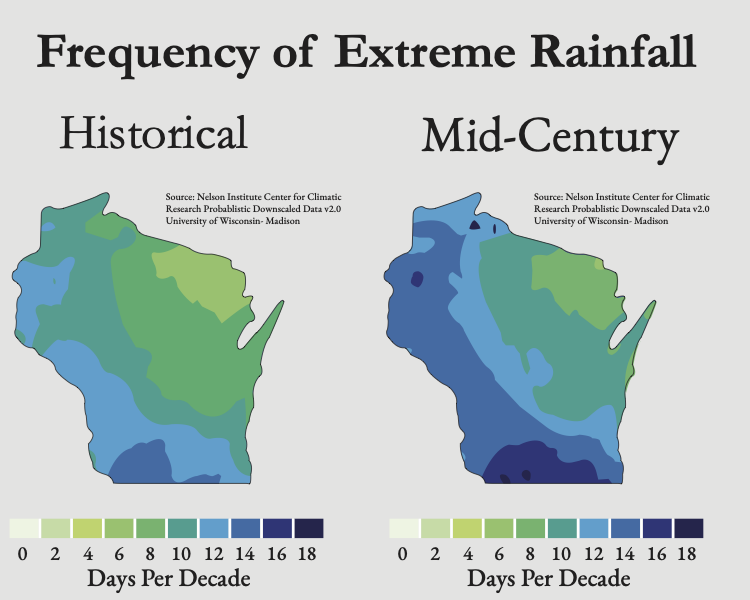Climate Change in Wisconsin
Madison has been labeled as a weather heaven by many news channels throughout the years along with San Diego and Honolulu. We have seen a huge increase int he amount of people who moved to Madison in the past few years partially due to the pleasant weather and availability of 4 seasons. It attracts a lot of people who are trying to avoid cold weather. If we compare current time to the decade from 1981 to 1990, Madison has experienced a great extend of a climate change.
Wisconsin has seen an increase of an average of 8 additional inches of precipitation per year since 2011. Four of Wisconsin’s five wettest years have taken place in the last decade, and 2019 was the soggiest year for both Wisconsin and the entire US.

Besides that, CO2 levels have drastically increased since 1900 in Wisconsin. Until 1900 CO2 levels were relatively stable between 150 and 280 ppm. As people started open factories and different manufacturing facilities across the Midwest, CO2 level started to increase at an incredibly fast rate.In 2020 CO2 level was measured at 415 ppm. Currently our CO2 levels are 40 percent higher than what they were before the industrial revolution.
As many other people, I noticed big changes in the seasonal temperatures. Wisconsin has warmed 2 to 3 degrees Fahrenheit since 1950, and it is projected that the state will warm an additional 2 to 8 degrees by 2050Spring temperatures have increased by 1.7 degrees Fahrenheit with the onset of spring coming three to 10 days earlier since 1950. Wisconsin winters are becoming less cold and have warmed more than any other season in recent decades, especially in the northwestern part of the state where average temperatures have increased by as much as 4.5 degrees Fahrenheit. Winters have already decreased in the amount of days the cold temperatures last and the amount of snow central Wisconsin is getting. It is anticipated that winter temperatures will continue to increase 5 to 11 degrees Fahrenheit. Winters will be milder by 2050 and most likely about one month shorter than they are today. There also will be less snow - about 14" fewer inches of snow.
I also have noticed the increase in the amount of days with extreme heat. Currently we have about 10 days per years that are officially defined to be "extreme heat", meaning that temperatures can be over 90 degrees Fahrenheit. Wisconsin is likely to become a much warmer state over the next few decades overall. Results show that Wisconsin has warmed 2 to 3 degrees Fahrenheit since 1950, and it is projected that the state will warm an additional 2 to 8 degrees by 2050. We will also likely see a tripling in the frequency of extreme heat - days with temperatures over 90 degrees Fahrenheit, rising from about 10 days per year in 2020 to about 30 days per year by 2050.

I think that the most important idea I'll take away from this course is that Midwest nature is very diverse. Although it's mostly flat, and prairie grasses cover the majority of the land, it makes soil very fertile which is ideal for farming. Wetlands are common and support the diversity of life across the Midwest. They are known for availability of herbaceous plants, such as grasses, reeds, and sedges, salt marshes, mangroves and peatlands, as well as providing habitat for aquatic species and other animals and plants.
References:
https://dnr.wisconsin.gov/climatechange/science
https://wicci.wisc.edu/wisconsin-climate-trends-and-projections/
https://www.cityofmadison.com/sustainability/climate/heat-resilience
Your post holds a lot of great information and some shocking statistics; it's disappointing to hear that CO2 levels have increased 40% since the industrial revolution. What disturbed me most is reading that by 2050, winter is projected to be about one whole month shorter with 14inches less snow. That is a drastic change that I hope we can curb!
ReplyDelete